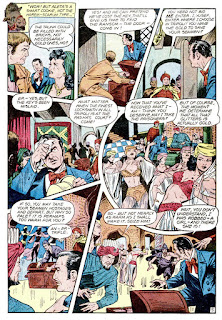Friar Diablo is a co-conspirator with Baron Doom, trying to find a treasure and also get rid of Captain Battle, and Captain Battle’s son, Captain Battle Jr. We have gone over my opinions of youthful companions of costumed heroes, and I would not be taking my son along to face some sorcery, but at least CB Jr is not one of those “wards” of a superhero, and if his dad wants to take him, well, I guess that is okay with me.
I like Friar Diablo’s magic words, which are just common words with an “o” on the end. For instance, all you would have to know is the everyday word, disappear, then shout “disappearo!” and your enemy would be gone. Very cool; I may try it on someone sometime.
Although they are shown flying, Captain Battle and his son cannot fly on their own. They are using Luceflyers strapped to their backs. Public Domain Superheroes tells us this about
Captain Battle: “He had no superpowers but has advanced technology, including the Curvoscope, which allowed him to see anywhere on earth, a Dissolvo Gun which disintegrated matter, a gyroscope-like Luceflyer, and a jetpack.” (Hmm, I’d be interested in something called a Curvoscope, and a Dissolvo Gun sounds very handy.)
At the very end of this adventure Captain Battle tells his son, “This race for treasure isn’t over yet!” but alas, it was. The story appeared in
Silver Streak Comics #21 (1942), which was the last issue of that comic. With issue number 22 it continued on as
Crime Does Not Pay — where the bad guys didn’t use magic, just tried-and-true guns and knives to get rid of their enemies.
The Grand Comics Database has no guess for a writer, but they credit Jack Binder with the artwork.



























































